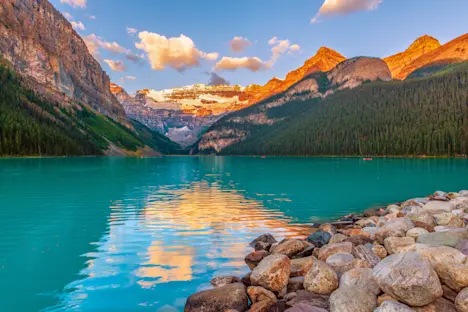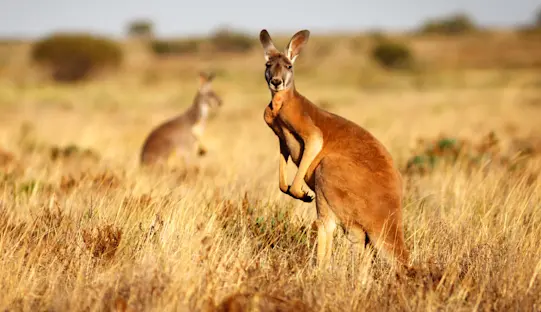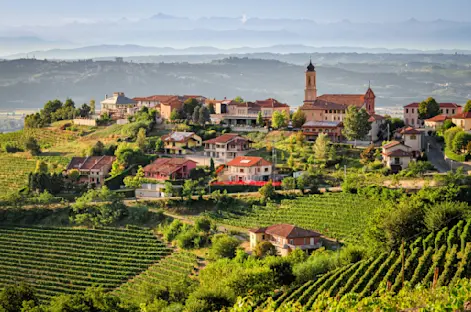
Bears have always enchanted me. I think of grizzly bears—along with wolves—as icons of wilderness. To be able to see or be close to a brown bear in the wild is, I think, the nearest we’ll ever get to the natural world. ©Candice Gaukel Andrews
We were sitting quietly, the two of us, on a log in the forested and tall-grass wilds of Alaska’s Lake Clark National Park and Preserve. Here, along the Cook Inlet coastline, are mountains, marshes, rivers, trees and lands that come together to make a good home for bears. I was thinking about this rare place where human footprints are relatively few and bear paw prints are rather numerous when a large, coastal brown bear and her cub parted the blades gently swaying directly in front of us and kept walking forward. My heart began to pound with this surprise appearance and the trajectory that inevitably led right to our spot; but otherwise, I froze. My companion, though, was still ambulatory. But she didn’t run, scream, wave her arms or move quickly. She simply stood up, and collectedly and slowly walked around the bench to the back of it, where she stood unobtrusively.
My companion that day was only nine years old.
Her name is Libby Lightning Andrews, and she is my granddaughter. I took her along with me on Natural Habitat Adventures Alaska Bear Camp trip because I wanted her to taste real wilderness; to connect with something big and free and natural. I wanted her to know that there are still a few places where grizzly bears—one of the largest land predators in North America—can still be bears.

To get to Bear Camp, Libby and I took a 30-minute charter flight from Homer, Alaska, across Cook Inlet to Chinitna Bay. The pilot had to time our arrival with the tides to ensure that we could land on the gravelly beach in front of the camp. ©Candice Gaukel Andrews
A bear camp in the tidal zone
Bears have always enchanted me. As a child, bears—or any kind of ursine creatures—were my favorite stuffies. I collected the cuddly versions of them well into college. Now, I think of grizzly bears—along with wolves—as the top representatives of wilderness itself. To be able to see or be close to a brown bear in the wild is, I think, the nearest we can ever get to the natural world.
I live in a suburb of Portland, Oregon, and I sometimes hear the calls of coyotes at night. Just feet from my front door is a nature trail that crosses over a densely wooded butte where the coyotes live. Sometimes, however, I wish for something bigger. I’ve heard rumors that in the recent past, there were cougars here, in my hills. Yet I still yearn for that which can conjure up feelings of ultimate wildness, bring claws and fur to my dreams, and inspire a fast heartbeat.
That’s why Nat Hab’s Alaska Bear Camp, adjacent to Lake Clark National Park and Preserve, called to me. The park happens to be one of the world’s most renowned bear-watching destinations. Located on the Pacific Ring of Fire, where the Alaska Range intersects the Aleutian Range, a diverse and spectacular landscape of bright, plant-covered, alpine tundra; turquoise lakes; jagged mountains; mazelike glaciers; and scenic river valleys is created. The classic, cone-shaped, 10,016-foot Iliamna Volcano is perennially covered in snow and ice, and numerous glaciers radiate from its summit. No roads lead to the park, so access is by boat or small aircraft—typically, the quintessential Alaska bush plane, the single-engine de Havilland Beaver. The production of these flying workhorses ceased in 1967.

We flew across the water, gazing at the scene-stealing, 10,016-foot Iliamna Volcano, which is perennially covered in snow and ice. Numerous glaciers radiate from its summit. ©Candice Gaukel Andrews
Bear Camp is located on Cook Inlet, an extremely dynamic, estuarine system dominated by the tidal cycle. According to the National Park Service, normal tidal heights can vary from 18 feet at Kachemak Bay to 29 feet at Anchorage, with extreme tides over 36 feet, giving Cook Inlet some of the largest tidal ranges in the world. Tidal fluctuations can be thought of as a basin being filled with water and then drained, carrying and depositing nutrients with each shift of the tide. These extreme tidal ranges produce strong currents that flow into the inlet, carrying organisms and saline-rich water and sediments, while also circulating nutrients and oxygen.
This water causes streams to rise, and tidal channels to form. As the tide changes, nutrients settle and become trapped among the plants. The mixing of marine and terrestrial nutrients creates highly productive and adaptable salt marshes along the coast, which draw hungry bears.
Libby and I journeyed with our fellow travelers to Bear Camp via a 30-minute charter flight from Homer, Alaska. The pilot timed our arrival with the tides to ensure we could land on the beach. Buckling inflatable life jackets around our waists, we climbed into the small Beaver plane, pulled on our headphones and flew across the water, gazing at Iliamna Volcano’s clouds, vents and glaciers, before landing on the gravelly beach in front of the camp. Behind the camp is one of those salt marshes full of sedges.

Because we follow protocols of behavior at Bear Camp, the bears never have reason to become alarmed around us. The bears see us as just another feature of the landscape, something to walk past without concern. ©Candice Gaukel Andrews
Social etiquette in a bear society
In truth, brown bears, like most bears anywhere, pose little threat to responsible humans. But my palpitating heart in the presence of the oncoming bears wasn’t completely out of line. In the state of Alaska between 2000 and 2017, there were 68 hospitalizations and 10 fatalities due to bear attacks. To put these numbers into context, however, during the same period in Alaska, the bear attack hospitalizations (which numbered 68) were substantially less common than dog-bite hospitalizations (467), bicycle-accident hospitalizations (1,825) and motor-vehicle-accident hospitalizations (8,283).
Because the bears in Lake Clark National Park and Preserve must fish in proximity to one another, they’ve learned to tolerate the presence of other animals. This ability and the plentiful food make them relatively nonchalant about sightseeing humans.
Nat Hab guides, of course, know how to keep visitors safe in bear country: walk in a cluster, not in a line; let the bears choose whether to get closer to us rather than vice versa; never allow multiple viewing groups to “wall off” a bear; and never consume food outside of designated eating areas. If these protocols are followed, the bears never have reason to become alarmed or conditioned to human food. In essence, we’re seen as just another feature of the landscape, something to walk past—sometimes very closely—without concern.

I couldn’t see this experience through Libby’s eyes. I only saw it—and her—through mine. And for me, being among the bears was a spiritual journey that let me glimpse the true, wild, natural world. I hope Libby felt some of the same things. ©Travis John Andrews
And although your first impulse when being so close to wild bears might be to get away as fast as you can, you quickly adjust. The bear and her cub who seemed to be on an inescapable path that bumped into Libby and me got within two feet of us, plopped down in the grass and, after a few playful swats of their paws, began to nap, as if this was all perfectly normal.
An extraordinary experience in an exceptional place
I wish I could say to you what’s usually said when talking about traveling with youngsters, such as “I saw the world through a child’s eyes” or “I was able to get in touch with my own childlike awe.” But I didn’t see this experience through Libby’s eyes. I could only see it—and her—through mine. And for me, being among the bears felt like a spiritual journey that let me briefly glimpse the natural, true, wild world. I hope Libby felt a bit of the same sensation.
What I can say is that now I do know that Libby doesn’t have to imagine a snowcapped volcano that rises more than 10,000 feet. She doesn’t have to envision a world where bears and people respect one another or what it would feel like to be accepted—even just for a short time—into a bear society. She doesn’t have to fantasize that there’s a place somewhere where the bear “others” still have room to be wild bears.

I believe that Libby now knows in her soul that there are still a few, rare places in this world where bears can still be bears. That’s because she’s been to one of them. ©Candice Gaukel Andrews
She doesn’t have to imagine any of that, because she now knows that these things exist.
She knows, because she’s been there.
Here’s to finding your true places and natural habitats,
Candy






























